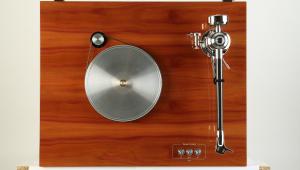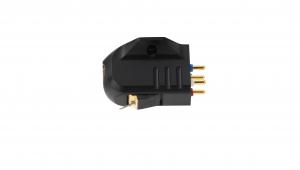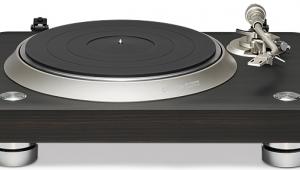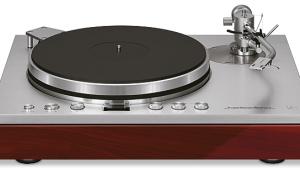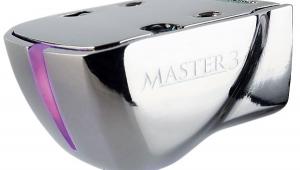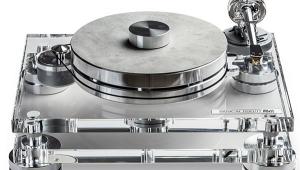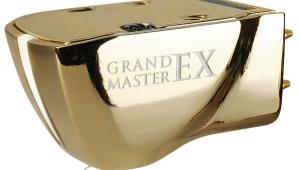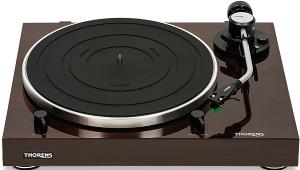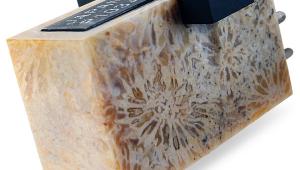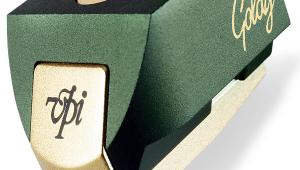Dual CS 5000 Turntable

 Surprisingly advanced yet appealingly affordable, this semi-automatic flagship deck from 1985 sought to unseat Rega's market-leader. How does it sound today?
Surprisingly advanced yet appealingly affordable, this semi-automatic flagship deck from 1985 sought to unseat Rega's market-leader. How does it sound today?
Vinyl fans in the early '80s were well catered for when it came to affordable turntables. If your budget was tight, the capable NAD 5120 made a fine starting point. But if you could stretch your funds a little further then there was only one choice: the Dual CS 505 [HFN Feb '13]. First introduced in 1981, it proved to be a robust and reliable performer at its bargain price of £75.
A few years later came an upgrade to this deck in the form of the CS 505-2, but by this time, Dual had decided it was time to bring the fight to the next level of the turntable market, which meant taking on the mighty Rega Planar 3. The design the company came up with in order to mount this challenge was the CS 5000 seen here.
Feet First
The CS 5000 was greeted by a few raised eyebrows when it appeared in 1985, being far more than a CS 505-2 given a quick spit and polish. Rather, it was surprisingly technologically advanced for what was still a relatively affordable turntable at around £200. It was based around a solid wooden plinth finished in either a real walnut veneer or the obligatory 1980s black ash. The plastic subchassis within this plinth was suspended, but unlike the CS 505, which used four springs for this, here the suspension was achieved via four adjustable shock-absorbing feet. The underside where these were mounted was reinforced with a metal plate, to add mass and rigidity.
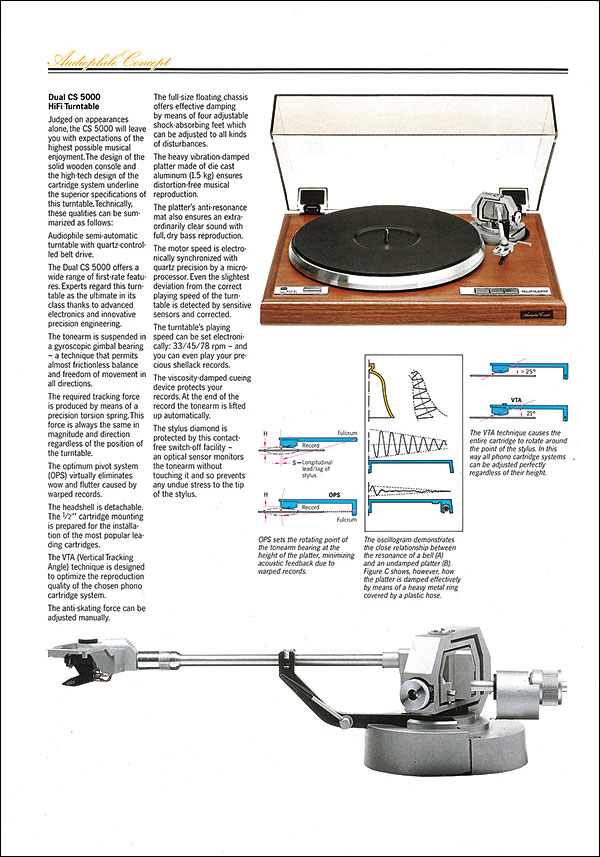
A 1.5kg diecast aluminium platter was at the heart of the deck and the underside of this featured a recess around its outer edge. Inside was fitted a metal ring, covered in plastic in a bid to damp unwanted platter vibrations, particularly at the periphery. Finally, the platter was topped by a rubber mat and spun on a stainless-steel bearing with a brass sleeve that was mounted to the turntable's plastic subchassis.
The CS 5000 was belt drive but, rather than use the synchronous AC motor of the CS 505 with its simple but highly effective 'orange segment' pulley for speed adjustment, Dual went more high-tech for its new flagship deck. The EDS 5000 motor used was a DC servo type, driven by a dedicated circuit quartz-referenced to each speed using a microprocessor. Speed adjustment was no longer offered, but Dual took the unusual step of adding a 78rpm speed option to the usual 33rpm and 45rpm settings. Meanwhile, the motor was mounted to the plastic subchassis using three resilient rubber mounts.
Pivots 'N' Platters
The tonearm that came with the CS 5000 was also new. It pivoted on a gyroscopic gimbal bearing with both tracking force and anti-skate compensation applied via springs. The arm also made use of Dual's Optimum Pivot System, or OPS, whereby the vertical pivot point of the arm was set at the height of the platter surface, rather than being above it, as would be the norm. Dual claimed that this reduced acoustic feedback from warped records. More importantly, it reduced the effective length of the path the stylus would take when tracking a 'bump', with a concurrent drop in the apparent speed variation that resulted.
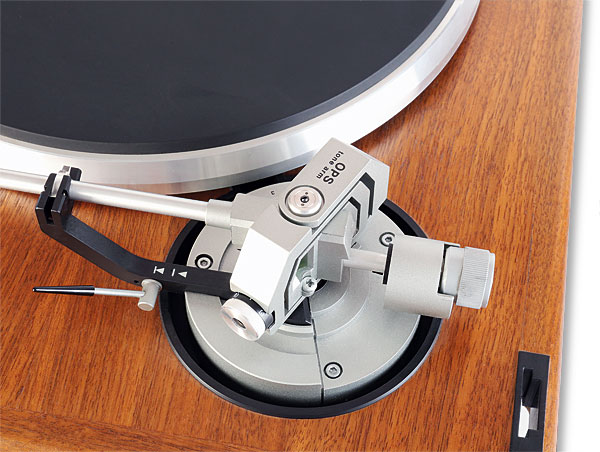
Cartridge Couture
A detachable headshell was used and the deck came supplied with an Ortofon OMB 20 E cartridge pre-fitted. This was another important step up from the CS 505, which had to make do with an Ortofon OMB 10. Meanwhile, a special stylus was available for the playing of 78rpm shellac records. Additionally, over the life of the CS 5000, three different headshell styles were offered. The first was a long, standard type that was silver in colour, though later in production this changed to a black plastic model very similar to that used on the CS 505-2. However, the CS 5000's is longer so the two are not interchangeable.
The really intriguing headshell option was the third one, the top of which sported a circular VTA adjustment knob. Rotation of the knob would vary the angle of the cartridge-mounting plate underneath by up to 5° in either direction. This was a clever way of circumventing the tonearm's lack of height adjustment, and a special VTA manual supplied with the turntable gave recommended settings for many of the popular cartridges of the day.
One of the most satisfying things about the CS 5000 was the way in which it operated. Dual stuck with semi-automatic operation for the deck which meant an automated stop-and-lift at the end of a record, rather than a fully automatic arm return. Most importantly, this was all carried out silently and sweetly using electronics as opposed to the effective, but rather clunky, mechanical methods employed in the CS 505. No flailing cueing levers at the end of the record here!
To start, the turntable would be powered up and 33rpm would be selected automatically. The speed was changed if the user desired, then the arm (which was cued 'up' at power on), would be manually moved over the surface of the record to a chosen track. At this point, the speed indicator LED would flash until the platter was up to speed and the quartz regulation locked in. Then the LED would illuminate steadily and the arm would automatically lower. Should any undue speed variations in the drive system occur (or indeed, if there was a power cut mid-LP), the arm would automatically lift.
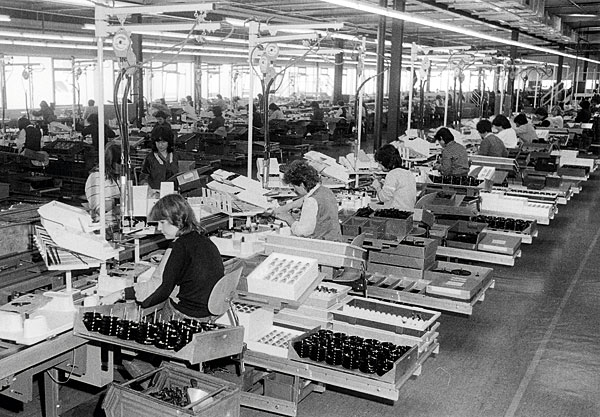
A separate cueing lever was also fitted to allow the arm to be lifted and moved during play, but this seems superfluous as pressing the selected speed-change button would also lift the arm to allow it to be manually re-positioned. Once moved, pressing the same button would return the stylus to the record. At the end of the LP, the arm lifted and the platter stopped.
Going For Gold
Despite its elegant styling and ease of use, the CS 5000 never really achieved the cult status of the CS 505. In 1987 it was superseded as Dual's flagship by the CS 7000 Golden One, which was largely similar in design to the CS 5000 but featured a gloss black plinth and some judicious gold plating of the platter and various arm components. It also swapped the dual-purpose speed/cueing buttons for a rotary control. A simplified model, the CS 750, also appeared around the same time as the CS 7000 Golden One. The design's final fling came in 1991 as the Golden Stone, which saw the CS 7000's black-and-gold tonearm and gold platter housed in an artificial stone plinth.
![]() Adam Listens
Adam Listens
It doesn't take too long when listening to the CS 5000 to realise that it really is a polished performer. While the CS 505 is a fine deck in its own right it can sound a little rough around the edges, but 'rough' is the last word to spring to mind here. The CS 5000 offers up a lovely sense of atmosphere and a rich, engaging midband that makes it an easy and compelling listen, no matter the music being played.





